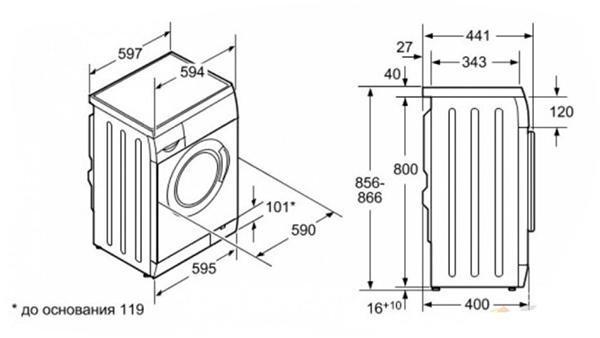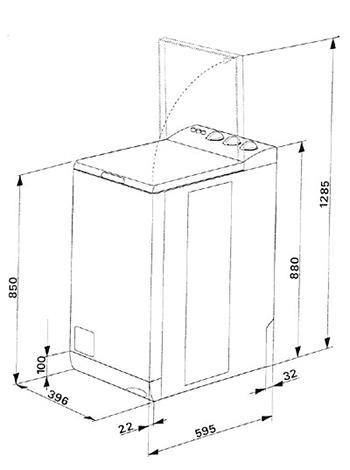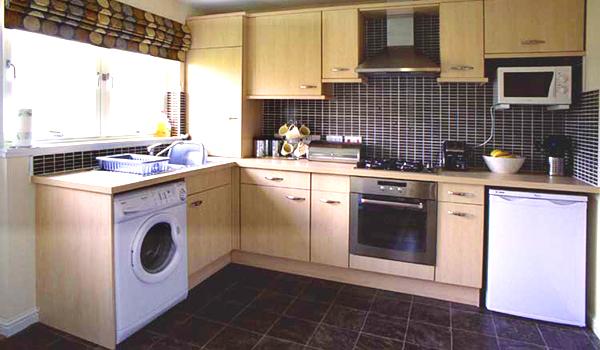Most of us are limited in room space, and before we buy furniture or large appliances, we need to be sure to choose a place for it. That is why it is best to pay attention to the dimensions of automatic washing machines before buying and choose the one that fits perfectly into your interior.
Although there are a lot of washing machines, their dimensions are in the same range. But even 1 cm can play an important role and allow the typewriter to fit into the bathroom or kitchen.
Front loading washing machine dimensions
The standard dimensions of front-loading washing machines can be divided into three components: width, depth, height. If about standard height washing machines we already wrote, then it is worth talking about other sizes separately.
Width
Width for front loading washing machines ranges from 60 to 85 cm. You can check the exact data with the seller or on the website of the home appliance store.
It is worth noting that models with a width of 60 cm are much more common, so you can take this figure as a standard size.

Washing machines with a standard width can be installed almost anywhere: they fit perfectly into the kitchen or bathroom without taking up much space.
Depth
The depth of washing machines is a more important parameter, because not only the amount of laundry that can be washed at a time, but also the presence of vibration during the spin cycle will depend on the depth.
The standard depth of washing machines ranges from 32 to 70 centimeters.. As you may have guessed, the narrowest washing machines can hold no more than 3.5 kg of laundry per wash, so their drum is quite narrow, which reduces the overall depth of the machine.
I would like to note that narrow washing machines have a smaller footprint, so they are more prone to vibrations during the spin cycle. In such washers, large counterweights are made to somehow compensate for this drawback, but the vibrations of narrow machines are still higher than those of deep ones.
Depth from 60 to 70 cm is usually washing machines with dryerbecause the large drum is required for normal drying of the laundry. The problem with such machines is that they may not fit into a standard 60 cm bathroom opening. Therefore, to carry such a large washing machine, you will have to remove the front panel or hatch cover.
The optimal automatic machine with a depth of 40 cm can hold up to 6 kg of laundry, while it fits perfectly into any interior and does not require additional effort to install. This option is suitable for the average Russian family.
Do not forget also that the machine needs to open the hatch to load the laundry. Therefore, when installing it, you need to take this moment into account and leave room for the normal opening of the door and a convenient approach to it.
In terms of height, frontal washing machines, unlike vertical ones, do not require free space from above. This plus allows you to embed such units in a kitchen set or under the sink.
By the way, if we talk about washing machines for embedding under the sink, then the dimensions of the front washing machines (especially the height) are much smaller than the standard ones, which makes it possible to place them in a smaller space.
Dimensions of top-loading washing machines
The dimensions of top-loading washing machines are slightly different than those with vertical loading. Such machines have a number of advantages, because they can fit into the tightest corners of your home.

Depth
The depth of top-loading washing machines is usually 60 cm. You can tell it's not small at all. However, apart from these 60 cm, you do not need additional space to open the hatch, so it can be placed right next to other furniture or against a wall.
Width
The width of such washing machines is usually 40-45 cm, which is very small. Again, you don't need extra space to open the door.
Based on all of the above data, the conclusion suggests itself that top-loading washing machines can be placed in the very corner and furniture can be placed close to it.
The height of such washers is standard and is 85 cm.. The disadvantage of top-loading machines is that they cannot be built into the kitchen under the countertop or under the sink in the bathroom, because they have a top-loading lid.
How to consider the size of washing machines when choosing
It is best to foresee a place for installing a new washing machine in advance and, based on this place, choose the right model.
The place for the washing machine must be selected taking into account its approximate dimensions. If it is a narrow washing machine with a load of up to 3.5 kg, then less space will be required.If you want a larger machine or a machine with a dryer, then you need to take care of a larger free area in advance.
In addition, if you decide to buy a washer with a depth of 60 cm or more, then you need to measure the doorways and make sure that it will pass through them, otherwise you need to prepare to remove the front panel to reduce the size of the new washer.
If you have chosen an approximate place for a washing machine, then you need to pay attention to the pipes that can pass behind it, they will not allow you to move the unit close to the wall.
If you decide to build a washing machine into the kitchen, then more carefully measure the size of the space for the typewriter, then choose the right model, using our tips and recommendations from the article "Built-in washing machines - an overview". Also pay attention to the presence of such an opportunity as a removable cover for embedding in washing machines.

Today, many washing machines are equipped with a removable cover that can be removed, thereby reducing the height of the unit.
For installation under the sink you will need a smaller washing machine. There are much fewer such machines on the market, but they still exist. Please note that a standard size washing machine will not fit under the sink. Also keep in mind that not every sink with a standard siphon will allow you to “plug in” even a small washing machine. That is why here you need to approach the choice of a washing machine and the choice of a sink in a complex manner.
